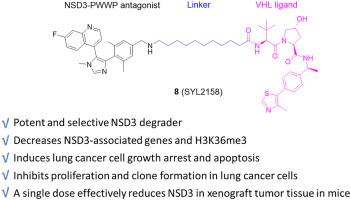European Journal of Medicinal Chemistry ( IF 6.7 ) Pub Date : 2022-06-13 , DOI: 10.1016/j.ejmech.2022.114528 Yaoliang Sun 1 , Ying Zhang 2 , Xiaoai Chen 3 , Aisong Yu 2 , Wenhao Du 3 , Yuting Huang 2 , Feifei Wu 4 , Lei Yu 5 , Jiayi Li 6 , Cuiyun Wen 1 , Hong Yang 7 , Qiongyu Shi 7 , Meiyu Geng 8 , Xun Huang 9 , Shilin Xu 10

|
Nuclear receptor binding SET domain protein 3 (NSD3) is an attractive potential target in the therapy for human cancers. Herein, we report the discovery of a series of small-molecule NSD3 degraders based on the proteolysis targeting chimera (PROTAC) strategy. The represented compound 8 induces NSD3 degradation with DC50 values of 1.43 and 0.94 μM in NCI–H1703 and A549 lung cancer cells, respectively, and shows selectivity over two other NSD proteins. 8 reduces histone H3 lysine 36 methylation and induces apoptosis and cell cycle arrest in lung cancer cells. Moreover, the RNA sequencing and immunohistochemistry assays showed that 8 downregulates NSD3-associated gene expression. Significantly, 8, but not 1 (a reported NSD3-PWWP antagonist) could inhibit the cell growth of NCI–H1703 and A549 cells. A single administration of 8 effectively decreases the NSD3 protein level in lung cancer xenograft models. Therefore, this study demonstrated that inducing NSD3 degradation is a more effective approach inhibiting the function of NSD3 than blocking the NSD3-PWWP domain, which may provide a potential therapeutic approach for lung cancer.
中文翻译:

NSD3组蛋白甲基转移酶的有效和选择性靶向嵌合体(PROTAC)降解剂的发现
核受体结合 SET 结构域蛋白 3 (NSD3) 是治疗人类癌症的一个有吸引力的潜在靶点。在此,我们报告了一系列基于蛋白水解靶向嵌合体 (PROTAC) 策略的小分子 NSD3 降解剂的发现。所示化合物8在 NCI-H1703 和 A549 肺癌细胞中诱导 NSD3 降解,DC 50值分别为 1.43 和 0.94 μM,并显示出对其他两种 NSD 蛋白的选择性。8减少组蛋白 H3 赖氨酸 36 甲基化并诱导肺癌细胞凋亡和细胞周期停滞。此外,RNA 测序和免疫组织化学分析表明,8下调 NSD3 相关基因的表达。显着,8,但不是1(报道的 NSD3-PWWP 拮抗剂)可以抑制 NCI-H1703 和 A549 细胞的细胞生长。单次给药8可有效降低肺癌异种移植模型中的 NSD3 蛋白水平。因此,本研究表明诱导 NSD3 降解是抑制 NSD3 功能比阻断 NSD3-PWWP 结构域更有效的方法,这可能为肺癌提供潜在的治疗方法。



























 京公网安备 11010802027423号
京公网安备 11010802027423号